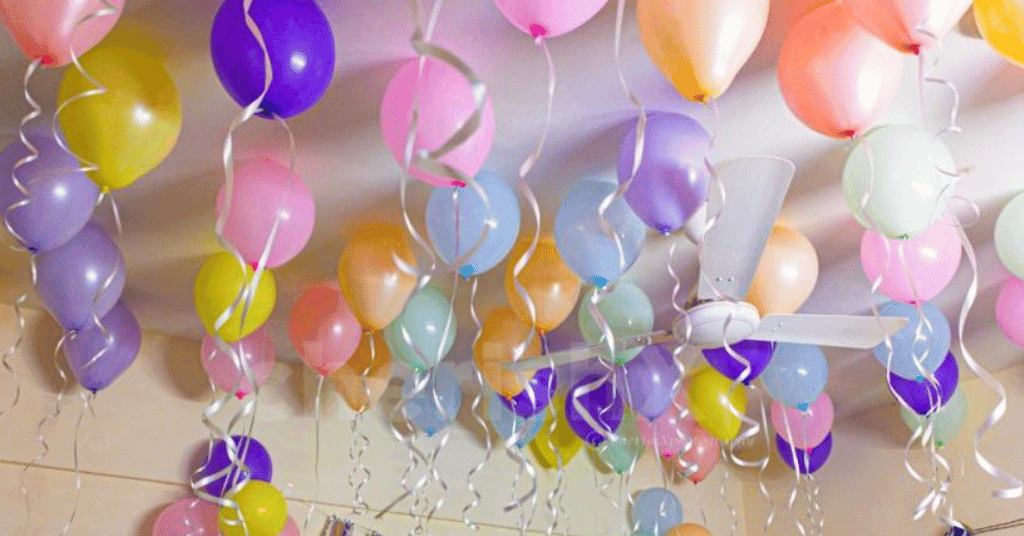In this blog, we will look into two easily available ideas to make floating balloons without helium at home.
Balloons have a magical quality that captures our imagination, be it in birthday parties, other celebrations, or just for fun. Moreover, be it a kid or adult, balloons always make everyone’s heart flutter with excitement and joy. Also, the balloon floating in the air give the next level of happiness in the heart. Have you ever wondered what makes these colorful balloons float effortlessly in the air? The secret lies in a gas called helium. In this article, we’ll explore the fascinating science behind helium and its role in making float balloons. We’ll also delve into two creative techniques to make floating balloons without helium for birthdays using readily available household items.
What is Helium, and How Do Balloons Float In The Air?
Helium, symbolized by “He” in the periodic table, is a noble gas. It is the second lightest element in the universe after hydrogen. It is colorless, odorless, and non-toxic, making it safe for a wide range of applications. Its low density allows it to rise in the atmosphere, making it an ideal choice for filling balloons. Also, helium is lighter than air and this lets the balloon float freely in the air.
So, when a balloon is filled with helium, it becomes lighter than the surrounding air, causing it to float upward. The principle involved here is buoyancy. The upward force exerted on the balloon by the surrounding air is greater than the downward force due to its weight. As a result, the balloon rises and floats easily in the air, creating a delightful spectacle. Now, let’s learn to make floating balloons without helium at home for an exciting birthday party. Ig you have a little one at home, then it’s a must to make a flying balloon together.
How To Make Balloon Float Without Helium – Get Creative Ideas
Idea 1 – How To Make Balloons Float Without Helium At Home?
If you’re planning someone’s birthday party at home and you urgently require to make balloons float without helium to elevate the vibe of the room, then here’s an idea. If you’re intrigued by science experiments and enjoy a touch of chemical magic, then this idea of making a flying balloon will captivate you. By combining some household items, you can create a simple yet mesmerizing experiment to make floating balloons without helium at home. You can simply do this using the reaction between hydroxide (caustic soda) and aluminum. Let’s explore the steps to make balloons float in the air.
Materials You’ll Need To Make Balloons Float Without Helium:
- – Caustic soda (also known as sodium hydroxide)
- – Aluminum foil (thin sheets or strips)
- – Water
- – A plastic bottle
- – Balloons
Prepare the Solution for Balloon Floating In The Air
– First, put on safety gear, including gloves and goggles, as caustic soda can be hazardous if not handled properly.
– In a well-ventilated area, add some water to the plastic bottle (approximately halfway full).
– Gradually add caustic soda to the water, stirring gently until it dissolves. Remember to be cautious while handling caustic soda.
Adding Aluminum:
– Carefully tear the aluminum foil into small pieces or strips.
– Drop the aluminum pieces into the bottle with the caustic soda solution. The reaction between aluminum and caustic soda releases hydrogen gas.
Inflate the Balloon:
– Take one of the balloons and carefully stretch the opening.
– Place the neck of the balloon over the bottle’s mouth without letting any gas escape.
Watch it Float:
– As the reaction between aluminum and caustic soda progresses, hydrogen gas is generated.
– The gas fills the balloon, causing it to rise and float elegantly in the air. Moreover, when you’ll see your balloons in the air, you will be elated for sure.
Safety Precautions:
– Remember to handle caustic soda with care, as it can cause burns if it comes into contact with the skin or eyes.
– Perform this experiment in a well-ventilated area and avoid inhaling any fumes.
PS: Yes, it’s that simple! Creating flying balloon without helium at home is surprisingly simple. With just a few easy steps, you can transform your ordinary room into a vibrant birthday party atmosphere using float balloons.
Idea 2 – Use Vinegar & Baking Soda To Make Floating Balloons Without Helium
If you prefer a less hazardous but equally captivating method to make float balloons, this idea is for you. With just a few common household items, you can create a fun experience that will leave everyone in awe. This is another simple way to create balloon floating in the air. Here’s how to make a flying balloon:
Materials You’ll Need To Make Balloons Float Without Helium:
- – Vinegar
- – A plastic bottle
- – Baking soda
- – Balloon
Preparation:
– Take the plastic bottle and fill it with a small amount of vinegar.
Inflate the Balloon:
– Carefully stretch the neck of the balloon.
Add Baking Soda:
– Take a spoonful of baking soda and carefully place it inside the balloon.
Secure the Balloon:
– Hold the balloon’s neck tightly to prevent the baking soda from falling out.
Attach the Balloon:
– Position the balloon’s neck over the mouth of the plastic bottle, ensuring the baking soda does not fall into the vinegar yet.
Release the Baking Soda:
– When ready, let the baking soda fall from the balloon into the vinegar.
Watch the Balloon Soar:
– As the baking soda reacts with vinegar, it produces carbon dioxide gas, inflating the balloon and causing it to float gracefully.
PS: Yes! It’s another simple way to make floating balloon without helium. Also, you can do this with your kids to add more excitement to your celebrations.
Conclusion
Hope you’ve understood “how to make balloons float without helium.” Float balloons have a magical ability to bring joy and wonder to people of all ages. You will love watching the balloons in the air. Understanding the science behind how helium makes them float adds an extra layer of fascination. In this article, we explored two captivating techniques to float balloons using everyday household items. No birthday party is complete without the whimsical touch of a floating balloon. But what if you find yourself in a last-minute situation without any flying balloons for the decorations? Don’t worry, we’ve got you covered with these creative ideas to make your party unforgettable, even without traditional helium balloons.
From the intriguing chemical reaction between caustic soda and aluminum to the delightful interaction between vinegar and baking soda, these experiments provide a hands-on experience that educates, entertains, and obviously you can make the best floating balloons without helium for a perfect birthday celebrations.
Suggested Read: How to Arrange a Perfect First Birthday Party at home >> 15 Must-See Ideas
FAQs
Will Balloons Float With Just Air?
No, regular latex or rubber balloons will not float with just air. In order for balloons to float, they need to be filled with a gas that is lighter than air, such as helium. Helium is less dense than the surrounding air, causing the balloon to rise and float. Moreover, you can now try out these creative experiments and witness balloon floating in the air.
How Do To Make Helium at Home?
There are household items like vinegar, aluminium, or caustic soda which create carbon dioxide. Moreover, these ingredients can be used to make balloons float in the air. However, creating helium at home is not possible. Helium is an inert gas and cannot be produced through DIY methods.
Can Oxygen Make a Balloon Float?
No, oxygen alone cannot make a balloon float. Balloons float when they are filled with a gas that is lighter than the surrounding air. While oxygen is necessary for human respiration and combustion, it is actually slightly heavier than the surrounding air.
How to Make Balloons Float At Home?
To make balloons float, you’ll need helium gas, which is lighter than air. Most party stores offer helium tank rentals. Simply inflate your balloons with helium, tie them securely, and watch them float gracefully.
How to Make Balloons Float Without Helium?
If you want your balloons to float without helium, you can use a mixture of baking soda and vinegar. Add baking soda to your balloons before inflating, and then add vinegar when you’re ready to release them. The chemical reaction will create carbon dioxide, causing your balloons to float.
How to Make Helium Gas with Baking Soda?
It’s not practical to create helium gas at home, as it requires extremely cold temperatures and specialized equipment. Helium is usually purchased in tanks from suppliers.
How to Make Helium Balloons at Home?
Making helium balloons at home isn’t feasible due to the complexities of obtaining and handling helium gas. It’s best to rely on commercial helium tank rentals for inflating balloons.
How to Make Floating Balloons?
To make balloons float, you can use helium gas. Rent a helium tank from a party store, inflate your balloons with it, and ensure they are tied securely. This will allow your balloons to float gracefully in the air. However, you can use a mixture of baking soda and vinegar. Add baking soda to your balloons before inflating, and then add vinegar when you’re ready to release them. The chemical reaction will create carbon dioxide, causing your balloons to float. So, here’s your answer for “how to make balloons float at home.”




